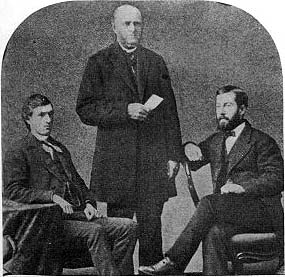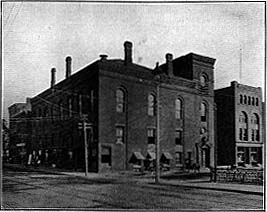|
Sketch of Holyoke by George H. Allyn, page 2 think a surveyor could re-trace the line. Over on Back street were the Goodyears, Rands, Humestons, Wolcotts, etc., and in Rock Valley the Danskes, Perkins, Howes, Ludingtons, etc., are frequently noted. We may speculate whether hard cider abounded in that region, and wonder if the results were then as later. Down on what we call the Ingleside road (there was no lower road in those days) were Peletiah Ely and Moses Ely and several Days. Over beyond Ashley Ponds, right at the West Springfield proper line of today, was a grist mill and hydraulic cement manufactory, and a little south, in West Springfield, on a brook, was a saw and shingle mill. Down near the present dam is shown a grist mill and cotton mill, which last must have been the fulling mill, operated by Warren Chapin. On Cherry street are shown the houses of Bishop Allen and Stephen Hayes, apparently where D.E. Day and J.B. Whitmore now reside, though the houses may have been rebuilt. In 1832 Chester Crafts bought the Abner Miller Inn property and conducted it as a tavern, store or post office till his death, in 1871. His brother, R.P. Crafts, afterwards mayor of Holyoke, drove a four-horse stage from Springfield to Northampton, about twenty miles, carrying mail and passengers. For three years, about 1842 to 1845, he was in partnership with his brother, under the name of Chester Crafts & Co., in general store keeping. Something stronger than water used to be sold in those old stage-driving, river-boating, canal-freighting and fishery days, and Deacon L.F. Thorpe used to relate that one Richard Thorpe, after imbibing somewhat freely at the tavern, had his bottle properly filled with new England rum, then proceeding up the road toward Easthampton. After toiling up the steep incline he laid down and fell asleep, and a wag, mowing in the field nearby, saw the bottle protruding from his pocket, emptied the contents into his dinner pail, refilled the flask with pure water from the brook, and left the wayfarer to awake later to shake his thirst. When he did so his wrath was boundless. He "beat it" back to the tavern and made the air blue with resentment. No human power could have convinced him that the aqua pura hadn't been placed in the bottle at the tavern, so his bottle was again refilled, free of charge. The last house this side of the then "Northampton line" noted on this map is that of Fred Street, but it was not probably the one now standing. Just beyond the line was Sherlock Thorpe, Whiting Street, and up near the present Whiting Street reservoir a little northeast, lived Moses and Phoebus Pomeroy, two thriftless mountain farmers, in "Pomeroy meadow." Moses, however, had an imaginative disposition and a turn of humor. He must have lived on until about 1850, as some of those still living clearly recall him. He used to relate to the credulous boys that sixty years agone there was no Mt. Tom, the view to Easthampton being clear and unobstructed. "But," said Moses, "one spring the floods were tremendous, and spread far and wide. One morning as I was looking up the swollen river, I saw what is Mt. Tom come floating majestically down. Several gigantic Indian warriors with paddles, made out of half-grown tree trunks, were keeping it in the course of the current. Just as it reached a point opposite where it now stands the current swung it off toward the Hadley side, and it almost grounded. But a gigantic savage, quick as a panther, dug his tree paddle into the shallows, and, with fearful strength, fended off so hard that a cross current impelled it to the west side, where it grounded hard and fast, shutting off our view of Easthampton. Moses claimed that rattlesnakes were so thick that it was sometimes impossible to hay, and that he went out one day with a dump cart pitched in a writhing load of them, carrying them home to feed the pigs. It was Moses, also, who passed the Fred Street place one evening with a pail, the content of which may be surmised. A maiden sister, noted for her curiosity, was in the year and called out inquiringly: "What have you got in your pail, Mr. Thorpe?" "Manners, by _____," replied the indignant Moses. Moses' rattlesnake tale had some little basis of truth, for E.R. Crafts relates that his brother-in-law, George Smith, and a relative named Merwin Allen in the late 50's killed twenty-six rattlesnakes at the mouth of "Snake Den," in the trap rock. The first serious attempt to utilize the great water power was when Warren Chapin, Asahel Chapin, and Alfred Smith procured legislative authority, as the Hadley Falls Company, to build a wing-dam, extending obliquely up the river, conducting the water into a canal above the Hampden Mill, Jr., which the concern built about 1831. This was designed for a cotton mill of 4,000 spindles. Thus, until 1847, the commercial and manufacturing potentialities of Holyoke were dormant.
 George Heywood, Jones S. Davis, and George L. Thayer
 Parsons Hall
The Northampton-Springfield Railroad Company, organized in 1842, changed their route from the east to the west side of the river, and completed the railroad in 1845 with seemingly inspired foresight. For in 1846, George C. Ewing, of the firm of Fairbanks & Co., of New York, began negotiations for land adjoining the falls; in March, 1847, had purchased thirty-seven acres, and a little later the mills and property of the original Hadley Falls Company, incorporated in 1829. The first development company, organized in 1847, included J.K. Mills, treasurer, John Chase of Chicopee and P. Anderson, a West Pointer, engineers and George C. Ewing, land agent. It was easy to discern grand possibilities in a series of rapids affording a fall of sixty feet in one and one-half miles. In 1848, Mr. Ewing resigned, the Fairbankses withdrew, and the property passed into the hands of a new Hadley Falls Company, which included George W. Lyman, Thomas H. Perkins, and Edmund Dwight. This company secured 1,100 acres of land and also the rights of the proprietors of the locks and canals at South Hadley Falls, or "Canal Village." The capitalization of the company is given by some authorities as one million and by others as four million.
| Previous Page | Next Page |
| People & Organizations | Allyn's Sketch of Holyoke |
| Selected Advertisments | Churches | Surname Index |
© Laurel O'Donnell 1996 - 2005, all rights reserved
This document may be downloaded for personal non-commercial use only and should not be reproduced or distributed without permission. |